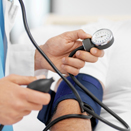How Exercise Can Help Control and Lower Your Blood Pressure
View All Section Pages

According to American Heart Association, nearly half of American adults have high blood pressure or hypertension. But because there are no symptoms, many people have high blood pressure for years without knowing it.
Uncontrolled high blood pressure can lead to stroke, heart attack, heart failure and kidney failure. This is why high blood pressure is often called the "silent killer." The only way to tell if you have high blood pressure is to have your blood pressure checked.
Blood Pressure 101
Blood pressure is the amount of pressure the blood forces against artery walls. Two forces create blood pressure. The first comes from the heart pumping the blood into arteries, and the second is the artery force resisting the blood flowing through them.
Normal blood pressure is 120/80 or lower. The top number is called your systolic pressure. This number is equivalent to the pressure caused when the heart contracts and pumps blood to the rest of your body. The lower number is called your diastolic pressure. This number corresponds to the pressure caused by the heart relaxing between beats.
Exercise is Medicine
The notion that exercise is medicine is true. Exercise can help control your blood pressure and decrease your chance of a heart attack or stroke. Exercise generally decreases both the systolic and diastolic components of your blood pressure value by about 10 points. This change does not take years of work, but can occur as early as one to three months after beginning an exercise routine. Many people worry about the cost and effects of blood pressure medications, yet regular physical activity can provide the same benefits.
Exercise can also help lower your chance of heart disease through weight control. Blood pressure can increase with unhealthy weight gain. Losing just 10 pounds may reduce your blood pressure significantly. Studies from The Cooper Institute demonstrate that individuals with high blood pressure who exercise regularly have lower death rates than those that do not exercise.
Aerobic exercise is the best exercise to help decrease high blood pressure. This can include walking, jogging, swimming, cycling or group fitness classes. These exercises do not have to be strenuous activities. A good rule is your heart rate and breathing should be increased, but you should still be able to carry on a conversation.
National guidelines recommend accumulating 30 minutes or more of moderate-intensity exercise on most days of the week with a goal of accumulating a total of 150 minutes per week. While finding 30 minutes of free time each day can seem like an impossible feat, begin with baby steps. This time can be broken up into smaller segments throughout the day.
To continue to see benefits you must maintain a consistent exercise routine. So, to keep yourself on track, try to make exercise enjoyable and interesting. Grab a friend or vary the frequency, intensity, amount of time or the type of exercise. Whatever you do, keep moving!
For more information or to schedule a comprehensive physical exam at Cooper Clinic, visit cooper-clinic.com or call 972.560.2667.
Article provided by Cooper Aerobics Marketing and Communications.